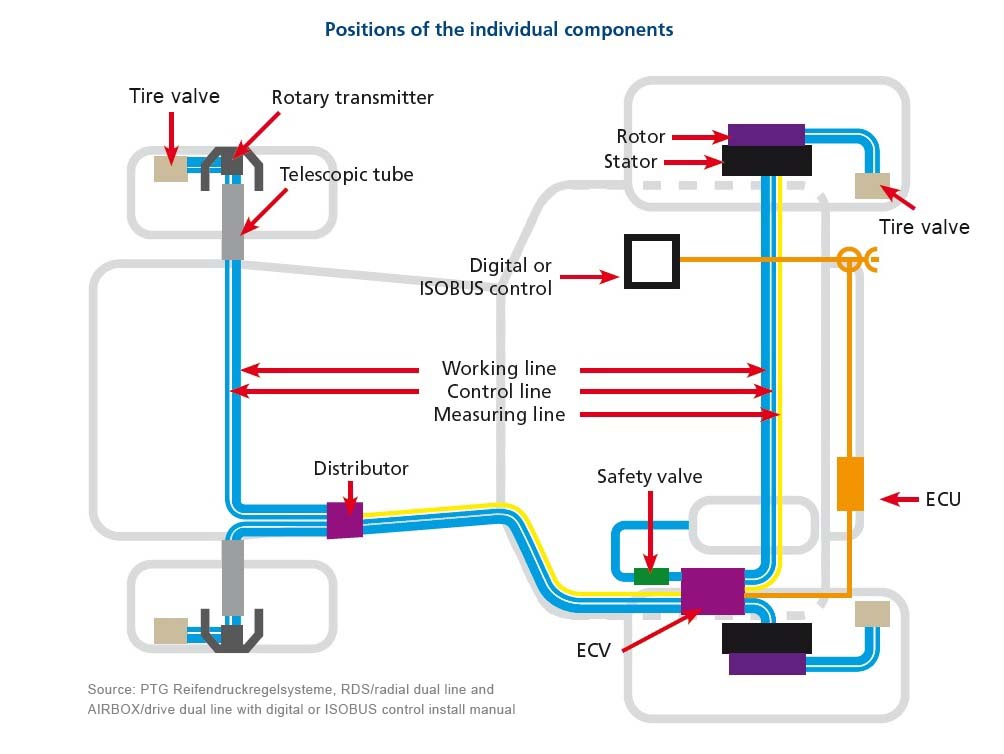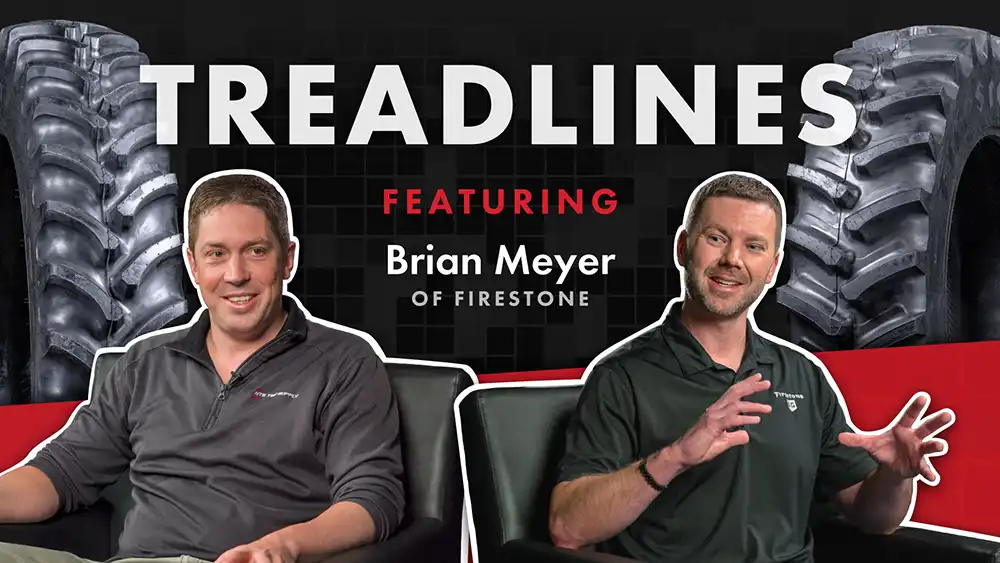A central tire inflation system can help solve one of your farm’s biggest challenges: compaction. Along with its side effects, compaction is the biggest profit stealer in your operation. Controlling compaction—safeguarding your soil—is one secret to boosting your yields. But the fix isn’t as simple as letting air out of your tires. For some of your farm’s largest machines, you need the ability to adjust your tire pressures throughout the day (and night) if you really want to get a grip on improving machine performance. And that’s why you need CTIS.

Our System Suppliers: AgriBrink and PTG
Iowa-based AgriBrink has been in the central tire inflation game since 2010, when the company owner, originally from the Netherlands, developed his first system for use on his own farm. The company sold its first system in 2012.
PTG (PTG Reifendruckregelsysteme GmbH) is based across the pond in Germany. Founded in 1991, PTG has a 30-year history devoted solely to engineering, producing, and selling central tire inflation systems. Today, Michelin owns the company.
1. How does a central inflation system benefit your operation?
CTIS allows you to optimize your tire pressure for the task at hand. Run your tires at their minimum safe pressures in the field to fight compaction and maximize traction. For roading, inflate your tires to their maximum pressure for safe, efficient road travel. Without a system, you’re stuck with compromise: a pressure that’s not optimized for field or road performance.
The Road: High Pressure & Low Rolling Resistance
90% of tire wear happens on the road. Heavy implements, long miles, and fast speeds spell trouble for tires. And with more farmers traveling more miles between fields, roading performance is more important than ever for farm tires. The tire companies themselves have responded with new, improved rubber compounds and tread designs engineered to deliver longer life on the road. But the tires need a little help from the operators, too. On the road, you ideally want your tires inflated to their maximum pressures. Why? You want the smallest footprint possible to minimize rolling resistance and heat buildup.
The Field: Low Pressure & High Efficiency
Once you’re rolling across the dirt, the opposite is true. In the field—where you make your money—you want the largest footprint possible for your machines. The last problem you want to cause is severe soil compaction, which can result in slow emergence, stunted roots, lower yields, and a host of other problems. So, you want your tires set to their minimum safe pressures in the field. This gives you the biggest footprint possible with your tire setup as well as more traction and flotation and a better ride to boot.
2. Why not just run tracks?
Because modern VF-rated radial tires do a better job of putting down uniform footprints. Tracks don’t distribute the tractor’s weight evenly across their footprints; the tractor’s load is concentrated on the areas of the track beneath its idler and bogie wheels. Plus, tracks are more expensive out of the gate, slower on the road, and can cause sticker shock when it comes to maintenance (and buying new belts).

The image above shows the high pressure points under each midroller. A study conducted by the University of Minnesota found that properly inflated duals will cause less compaction than tracks. Because tires are essentially rolling air chambers, they distribute the load evenly across their surface area.

As you’ll notice in the above chart, air pressure is vital to maintaining a tire’s compaction edge over its track competition. Outfitting a heavy tractor with tires that can run on lower air pressures (and adjusting your tire pressure for specific applications) will help prevent yield-killing compaction. In the study above, 6 and 7 PSI (front and rear respectively) was the optimal tire pressure for the 710/70R38 duals. The "overinflated duals" were set to 24 PSI.
3. What are the basic system components?
The easiest way to explain this one is to follow AgriBrink’s lead and divide a system up into three main components:
- Air Supply
In other words, an air compressor. The compressor may already be on your machine (as on a center-fill planter, for example), or you may need to add a compressor as part of a system package. In order to work, every CTIS needs air. - Air Control
The “brains” of the system, which include the in-cab controller, air distribution units, the ECU, etc. - Air Delivery
The air lines and wheel valves and all the supporting brackets and other parts.

Above is an illustration provided by PTG that shows its main system components. It’s a bit more detailed than our breakout above and the location of the various components can change based on install requirements, but this gives you an idea of what is all involved to make a system work.
4. How are PTG and AgriBrink inflation systems different?
There are a few key differences, which we’ll spell out in basic terms here. (When it comes to choosing the system that’s right for your application, it’s best to talk with our CTIS expert.)
Number of Air Lines
PTG has designed what it calls a “dual line” system, which uses a main air supply line and a smaller control line that opens and closes the wheel valves. (PTG also uses a third measuring line as well that runs to certain wheels to monitor tire pressure across the system.) PTG air lines are plastic and are run through protective conduit.
AgriBrink’s system uses a single air line made from DOT air brake hose.
System Pressurization
A PTG system is only pressurized when it is checking or changing tire pressures. According to PTG, this helps increase the overall lifespan of the system, as system components are only briefly pressurized.
In contrast, AgriBrink’s system is constantly pressurized. The folks at AgriBrink explained that they haven’t had any issues and the components, such as the air lines, are designed to handle the pressure.
System Ordering
PTG prefers to sell its systems as kits. So, if you have a John Deere 8R, you’d buy an 8R kit. From AgriBrink’s point of view, the company only sells one system. During the ordering process, you’ll work with NTS’s CTIS expert (and we’ll work with AgriBrink) to get the exact system you need for your application.
For example, if you want your tires to inflate super fast (under 3 minutes), AgriBrink can probably make that happen. Just be aware—the more compressor power you want, the more you’re going to invest to make it a reality. On the PTG side, compressors are sized to provide a 3–5 minute inflation time with each kit.
Deflation Time
While inflation time has been a focus of both manufacturers, AgriBrink is especially proud of its deflation time. Why is this a big deal? Think about custom manure haulers, for example. When they hit the field, they don’t want to wait to deflate; they need to keep rolling. No matter the system, AgriBrink promises deflation of all the tires in 30 seconds or less.
System Control
PTG offers a digital controller or ISOBUS app for controlling its systems. Each can change tire pressures on three “zones” (front and rear tractor axles and a center-fill planter, for example). As expected, the ISOBUS option comes with more bells and whistles, such as the ability to save a bunch of machine profiles.
AgriBrink systems control “channels” from one of three controllers—either basic or digital controllers or an ISOBUS app. Similar to PTG, one channel can be multiple axles, such as the axles on a manure tanker.
With the basic controller, the system’s air lines are routed into the cab and control is, well, basic—two hand-turn knobs, a toggle switch, and a pressure dial. Want your system to control more channels? You can add more controllers. AgriBrink’s digital controller or ISOBUS app can run up to 6 channels.
6. Would I get a flat tire if an air line breaks?
Both companies have safeguards built into their systems to prevent this from happening. On the PTG side of the fence, remember that once tires are inflated (or deflated) to their target pressures, there’s no longer any air pressure in the system. The wheel valves close and pressure is released in all the air lines. If you’d lose an airline, you wouldn’t be able to use the system to adjust the tire pressure on that particular tire, but you’d be able to keep running.
With an AgriBrink system, if an air line would break, you may have to hop down from the cab and manually close a valve at the wheel to prevent the tire from going flat. AgriBrink systems do have minimum pressure valves at the tires that hold pressure in the event of an air line break. The valves automatically close at around 12 psi. However, if the inflation system is used on a machine, such as a tractor, where the field pressure would normally be set below 12 psi, the system will not have minimum pressure valves. So, should an air line break in that case, you’d be faced with hopping down from the cab to manually close the valve at the affected tire. However, AgriBrink uses DOT air brake hose for its air lines, which is durable and not easily compromised.
7. Can I install a system myself?
Yes! While we offer professional installation within 150 miles of our service hubs, some customers choose to install systems themselves. However, install does require some mechanical experience and judgement. For example, with an AgriBrink system, you’ll need to weld the company’s wheel valves to your rims (PTG’s wheel valves are threaded into the rim). In this video, a farmer narrates the installation of a PTG system on a John Deere DB66 planter. PTG CTIS install on a DB66 planter
8. Why is there no “typical” installation?
Even with PTG’s “kit” approach, there is no typical installations because machines can vary so much. Take a tractor, for example. One farmer might choose to install the compressor in front of the cab beside the engine compartment. But another farmer might mount the compressor on the rear axle or behind the cab because he mounts tanks beside the engine compartment for planting and spraying.
9. Do I get a heap of parts when I order?
Whether you order a PTG or AgriBrink system, we’ll work with you and the inflation system company to supply you with all the system parts you’re going to need. You will need to have some basic shop supplies such as thread sealing compound, silicone, etc.
10. What if I’m going to sell my machine in two years?
It is possible to transfer a system to another machine.You may have to purchase some additional components (new hoses, wheel valves), but the “brains” of the system (compressor, controller(s), ERV) will transfer to a new machine. And as systems become more common, additional resale value for an equipped machine may even help you offset the cost of another system on your new sprayer, tractor, or other machine.
Stop Compaction in 2026 and Beyond
Compaction can occur year round—from planting to tillage and every pass in between. The good news is, you can mount an inflation system on most of your equipment:
• Planter
• Tractor(s)
• Sprayer (self-propelled or trailed)
• Tankers (manure)
Concerned about compaction and want to add more bushels to your bins in 2022? Talk with an expert at NTS Tire Supply to see if a central tire inflation system is a smart investment for your operation. When you take steps to safeguard your soil, you will Drive Your Farm Forward.

.png)
.jpg)



















